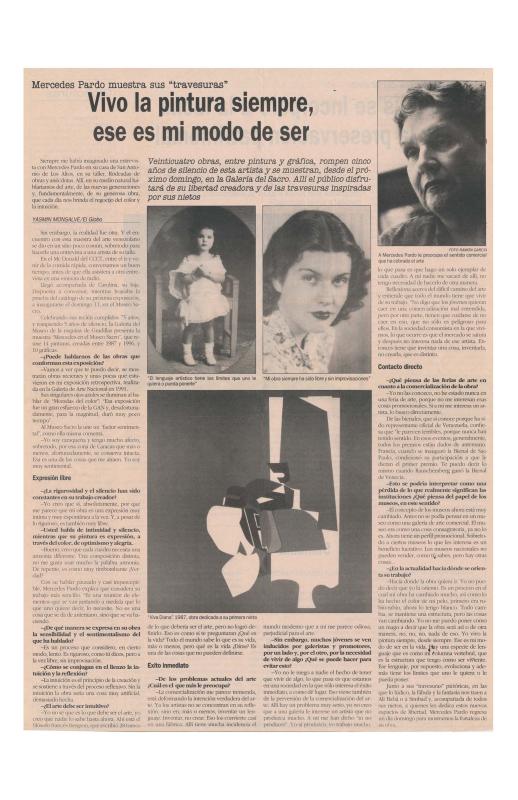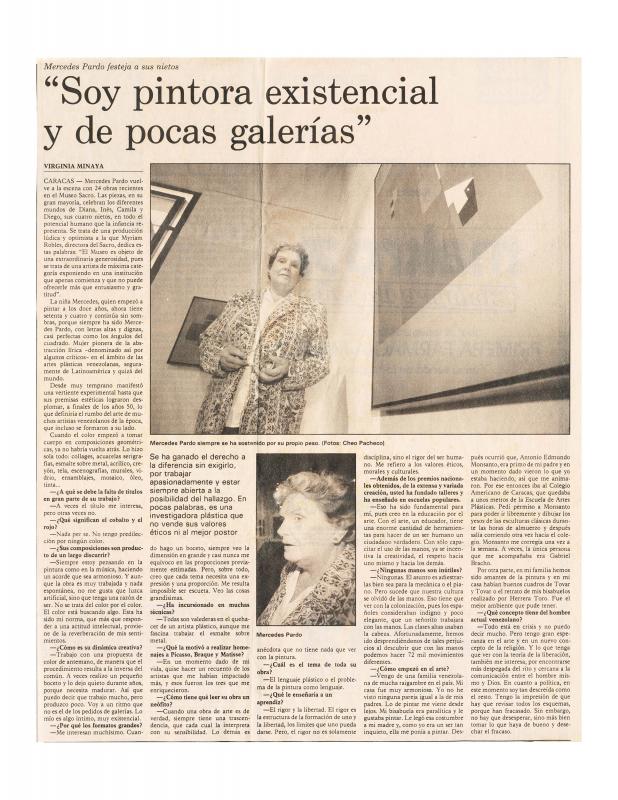Miriam Freilich presents the retrospective of the work of Mercedes Pardo (1921–2005), Moradas del color, from an unusual angle. While many reviews focus on the formal and contextual qualities of the works on view, Freilich concentrates on the social aspects of Pardo’s discourse and life. The interview begins with questions on the artist’s engagement with her community, referring to her work in schools, her views on the roles of educators, and on the social roles of artists themselves. The Venezuelan journalist poignantly observes that artists’ commitment to their society has become a façade rather than a genuine interest and acknowledges Pardo as “exemplary.”
In the discussion Pardo affirms that, for her, “art is revelation and not production,” a quote that became the title of the article. This statement leads to a dialogue on art systems, and on the roles that art critics, commercial galleries, and institutions play in the success of emerging artists. Pardo speaks of a “commercial distortion” of art and refers to nineteenth- and early twentieth-century “marchands de tableaux,” giving Ambroise Vollard as an example of how art dealers can indeed become part of history. France, Pardo argues, has followed that tradition with gallery owners who (like Vollard) truly supported and guided their artists and were willing to take risks to promote them. She mentions Galerie Louise Leiris, Galerie Maeght, and Galerie Denise René as key followers of this tradition. While the article wrongly mentions “Henry Canvailey,” Pardo here is referring to Daniel Henri-Kahnweiler, the German art dealer who championed Picasso, Braque, and Cubism more generally. Leiris was Kahnweiler’s sister-in-law, who took over his Parisian gallery—known as Galerie Simon (1920–40)—and renamed it Galerie Louise Leiris, supporting Surrealism as well as Cubism. Galerie Maeght, in turn, is another historical French gallery (Paris, 1945) championing Fauvism and especially Matisse and Bonnard. The article associates the gallery with Alexander Calder and Joan Miró, both connected with the history of the gallery, which was not just an exhibition space but a place for cultural exchange and debate. Pardo affirms that the last example of such a committed approach to their artists is Galerie Denise René, a key promoter of geometric abstraction in France and her galleries were a historical hub for Latin American artists of the trend. Indeed, Pardo was well acquainted with the Parisian art milieu. Thanks to a governmental scholarship from the Venezuelan Ministry of Education, she studied art history at the École du Louvre under Jean Cassou (1949), the first director of the Musée national d'Art moderne in Paris (1940–41). At that time, she started experimenting with abstraction for the first time, returning from 1960 to 1964 with Alejandro Otero, when two other Venezuelan pioneers of abstraction living there, Carlos Cruz-Diez and Jesús Rafael Soto, were involved with the activities of Galerie Denise René.
[For further reading on Mercedes Pardo’s views on the commercialization of art, see in the ICAA Digital Archive: Yasmin Monsalve, “Vivo la pintura siempre, ese es mi modo de ser” (doc. no. 1331036); and Virginia Minaya, “Soy pintora existencial y de pocas galerías” (doc. no. 1331020). Other documents on Moradas del Color include Gloria Carnevali, “El Espacio en la pintura de Mercedes Pardo” (doc. no. 1102285); and María Fernanda Palacios, “Pintura y vida” (doc. no. 1102253).]




